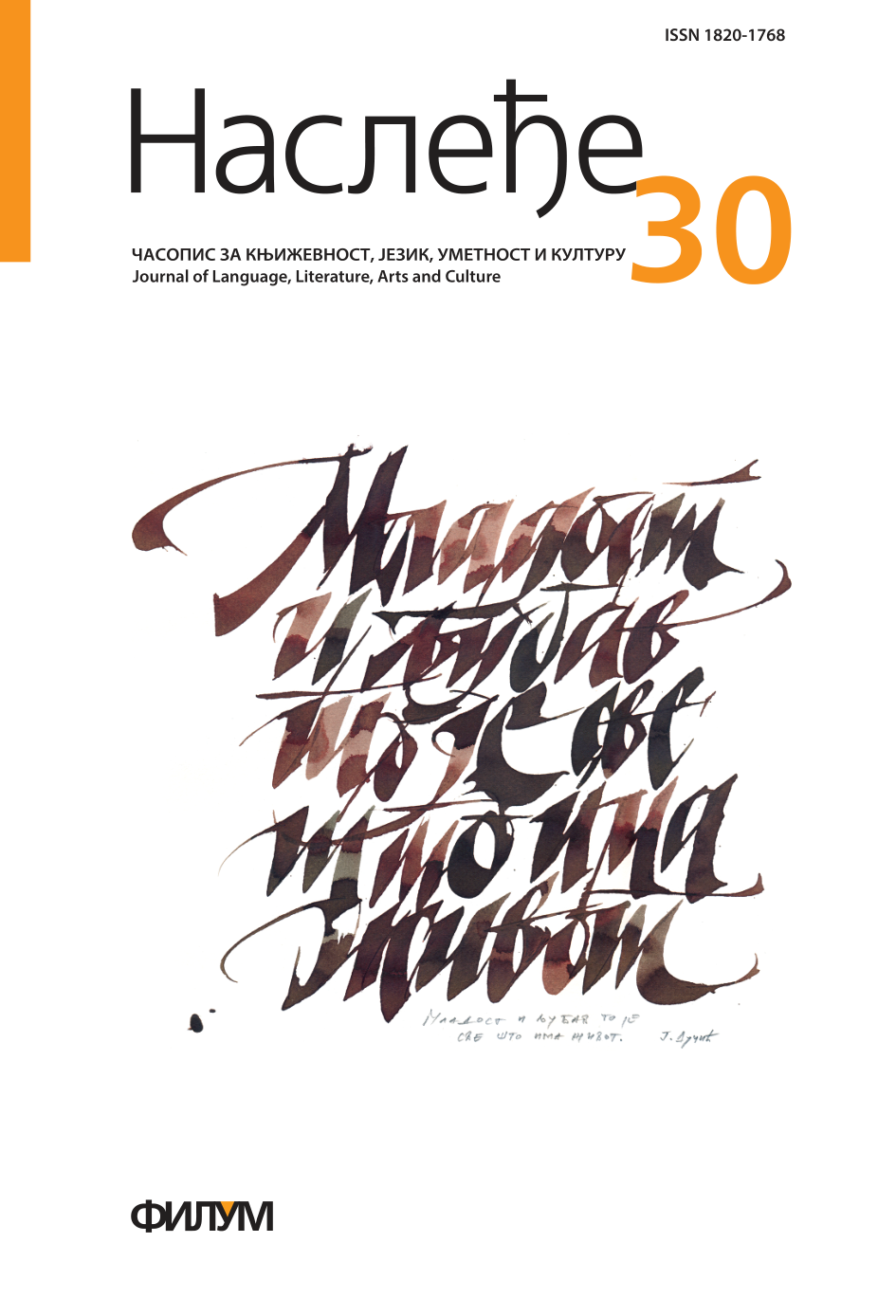ГРАМАТИЧКА ОБЕЛЕЖЈА СЛОБОДНОГ НЕУПРАВНОГ ГОВОРА У РОМАНИМА ЏЕЈН ОСТИН
Кључне речи:
слободни неуправни говор, граматичка реализација, граматички показатељиСажетак
У раду се разматра реализација слободног неуправног говора (СНГ) у романима Џејн Остин: Разум и осећајност (1811), Гордост и предрасуда (1813), Мансфилд парк (1814), Ема (1815), Нортенгерска опатија (1818) и Под туђим утицајем (1818). Циљ је испитати владајуће мишљење да слободни неуправни говор у стваралаштву Џејн Остин, као његове зачетнице, не би требало посматрати кроз призму модела какав се среће у савременој књижевности. Међутим, анализа ће показати да су одступања од модела описаног у литератури занемарљива и да је слободни неуправни говор још у својим зачецима имао иста граматичка обележја каква има и данас.
Референце
Ostin 1948a: J. Austen, Emma. London: Allan Wingate.
Ostin 1948б: J. Austen, Sense and Sensibility. London: Allan Wingate.
Ostin 1964: J. Austen, Pride and Prejudice. London: OUP.
Ostin 1985: J. Austen, Pride and Prejudice, Mansfield Park, Persuasion. London: OUP.
Ostin 1994: J. Austen, Northanger Abbey. London: Penguin.
Baldik 2001: C. Baldick, The Concise Oxford Dictionary of Literary Terms. New York: OUP.
Bahtin 1980: M. Bahtin, Marksizam i filozofija jezika. Beograd: Nolit. Preveo sa ruskog Radovan Matijašević.
Vale 1993: E. Valle, Narratological and Pragmatic Aspects of the Translation into Finnish of Doris Lessing’s Four-Gated City, In: Y. Gambier and J. Tommola (eds.): Translation and Knowledge, SSOTT VI, 245–261.
Veters 1994: C. Vetters, Free Indirect Speech in French, In: Vet, Co and Vetters (eds.): Tense and Aspect in Discourse: Studies and Monographs, 75, 179–226.
Gan 2004: D. P. Gun, Free indirect Discourse and Narrative Authority in Ema, Narrative, 12/1, 35–54.
Karavesović 2010: D. Karavesović, Slobodni neupravni govor: englesko-srpske paralele, Nasleđe, VII, 15/1, 143–152.
Klitgard 2004: I. Klitgard, Dual Voice and Dual Style: Translating Free Indirect Discourse in Ulyssis, Nordic Journal of English Studies, 3/3, 319–345.
Kovačević 2012: M. Kovačević, O gramatičko-stilističkom terminosistemu tuđeg govora, Srpski jezik, Beograd, XVII, 13–38.
Kon 1978: D. Cohn, Transparent Minds: Narrative Modes of Presenting Consciuosness in Fiction. Princeton: PUP.
Lips 1926: М. Lips, Le Style Indirect Libre. Paris: Payot.
Maier 2012: E. Maier, Quotation and Unquotation in Free Indirect Discourse, Ms 2012, Groningen. http://dl.dropboxusercontent.com/u/109312/pub/emar-maier-2012-freeindirect-discourse-draft.pdf. 08. 06. 2013.
Mihelson 1990: P. H. Michaelson, Reading Pride and Prejudice, Eighteenth-Century Fiction, 3/1, 65–76.
Mulan 2006: J. Mullan, How Novels Work?. Oxford: OUP.
Popović 2007: T. Popović, Rečnik književnih termina. Beograd: Logos Art.
Prins 2003: G. Prince, A Dictionary of Narratology. Lincoln: University of Nebraska Press.
Rajić 1996: J. Rajić, Slobodni indirektni govor u španskom i mogućnost njegovog prevođenja na srpski, Južnoslovenski filolog, 52, 175–191.
Taivalkoski Šilov 1999: K. Tavalkoski – Shilov, When Two Become One: Reported Discourse Viewed through a Translatologica Perspective. http://www2.arts.kuleuven.be/info/bestanden-div/Kristiina%20TAIVALKOSKI-SHILOV,%20When%20Two%20Become%20One.pdf. 08. 06. 2013.






